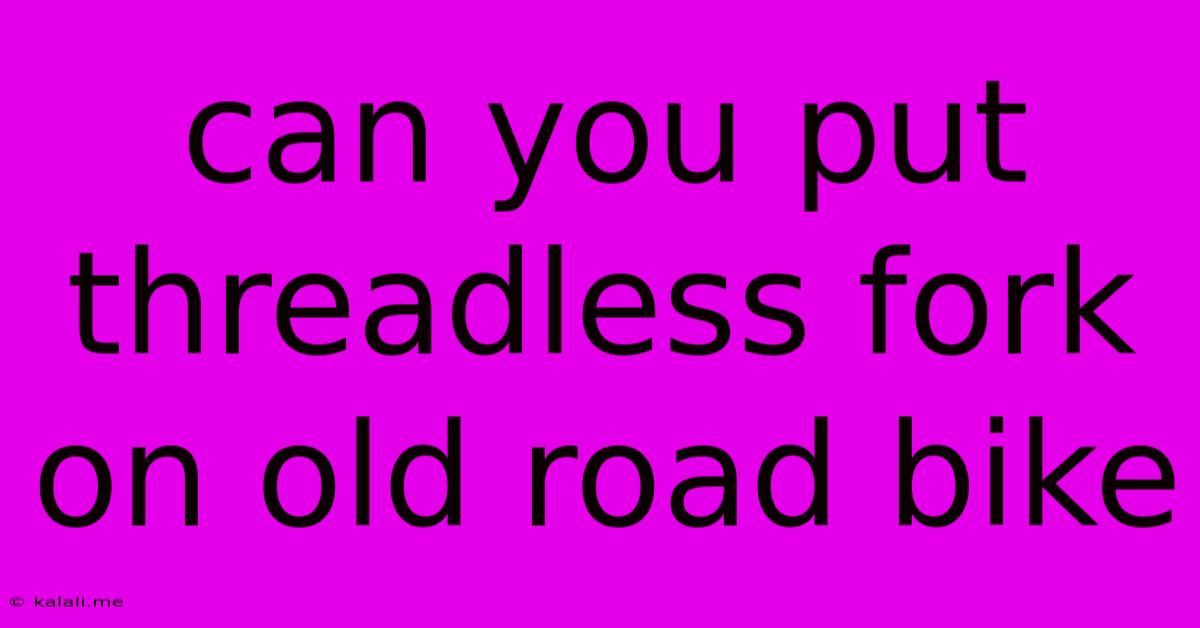Can You Put Threadless Fork On Old Road Bike
Kalali
Jun 05, 2025 · 4 min read

Table of Contents
Can You Put a Threadless Fork on an Old Road Bike? A Comprehensive Guide
Meta Description: Want to upgrade your classic road bike with a threadless fork? This guide explores the feasibility, challenges, and steps involved in converting your threaded headset to a threadless system. Learn about compatibility, necessary components, and potential pitfalls.
Upgrading your vintage road bike can be a rewarding experience, and swapping out the fork is a popular modification. But if your trusty steed boasts a traditional threaded headset, fitting a modern threadless fork might seem impossible. While it's not a simple bolt-on affair, it is achievable with the right parts and knowledge. This guide will walk you through the process, highlighting the crucial considerations and potential challenges.
Understanding the Difference: Threaded vs. Threadless Headsets
Before diving into the conversion, let's understand the fundamental difference. Threaded headsets use threaded cups that screw directly into the head tube of your frame. The fork's steerer tube is then secured with a compression bolt. Threadless headsets, on the other hand, utilize a compression system that clamps the fork's steerer tube between two bearing races housed within the headset cups. This system offers greater adjustability and is far more common on modern bikes.
Is it Possible? Assessing Compatibility
The possibility of fitting a threadless fork depends largely on your bike frame's head tube. Here's what you need to consider:
- Head Tube Diameter: You'll need to measure the inside diameter of your head tube. This will determine the size of the headset you'll need to purchase. Common sizes include 1", 1 1/8", and even 1.5" on some older frames. Note that many older frames are 1 inch, requiring a specific type of threadless headset conversion.
- Head Tube Length: A sufficiently long head tube is crucial. Threadless headsets require more space than threaded ones. Insufficient head tube length might prevent the installation of the new headset and spacers.
- Fork Steerer Tube Diameter: Ensure the diameter of your new threadless fork’s steerer tube matches the headset you've chosen.
- Frame Material: Steel frames are generally more forgiving during conversions than aluminum or carbon fiber frames. Aluminum and carbon are more prone to cracking under excessive force.
Necessary Components for Conversion
Successfully converting your bike will require these components:
- Threadless Headset: This is the core component, designed to fit your head tube diameter and the new fork's steerer tube diameter. Choosing the right headset is crucial for proper fit and function.
- Threadless Fork: Make sure the steerer tube diameter matches your chosen headset.
- Star Nut (for threadless forks): This nut sits at the top of the steerer tube and is crucial for proper clamping and fork adjustment.
- Spacers (potentially): Depending on your frame's head tube length and stem height, you'll likely need spacers to achieve the correct handlebar height.
Steps to Conversion
This is a complex process best left to experienced mechanics. However, here's a general overview of the steps involved:
- Remove the old threaded headset: This often requires specialized tools.
- Prepare the head tube: Clean the head tube thoroughly to ensure a smooth fit for the new headset.
- Install the new headset cups: Carefully press the headset cups into the head tube, ensuring they are seated correctly.
- Install the star nut: Secure the star nut at the top of the steerer tube.
- Insert the fork: Insert the steerer tube into the headset, ensuring proper alignment.
- Adjust the spacers and stem: Add spacers as needed to achieve the desired handlebar height and install your stem.
- Tighten and adjust: Tighten all components securely, carefully following the manufacturer's instructions.
Potential Pitfalls and Considerations
- Frame Damage: Improper installation can damage your frame. Seek professional help if you are not comfortable with the process.
- Compatibility Issues: Incompatibility between the frame, headset, and fork is a major concern. Thoroughly check dimensions before purchasing.
- Wheel Alignment: After installation, ensure your wheels are properly aligned.
Conclusion:
Converting your old road bike to a threadless fork is possible but requires careful planning and attention to detail. If you lack the experience or tools, seeking professional help from a reputable bicycle mechanic is strongly recommended to avoid damaging your valuable bike. Properly executed, this upgrade can significantly improve your riding experience. Remember to prioritize safety and accuracy throughout the entire process.
Latest Posts
Latest Posts
-
How Do I Change The Fog Distance On Phone
Jun 07, 2025
-
How To Find The Orthogonal Complement
Jun 07, 2025
-
Why Isnt My Mob Farm Working
Jun 07, 2025
-
How Much Core For Miecraft Server
Jun 07, 2025
-
How To Run A Rpm File In Linux
Jun 07, 2025
Related Post
Thank you for visiting our website which covers about Can You Put Threadless Fork On Old Road Bike . We hope the information provided has been useful to you. Feel free to contact us if you have any questions or need further assistance. See you next time and don't miss to bookmark.